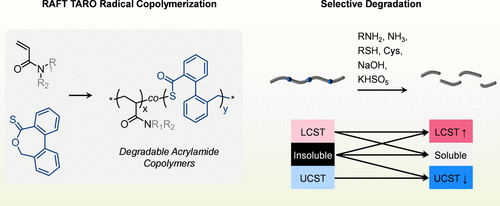当前位置:
X-MOL 学术
›
ACS Appl. Polym. Mater.
›
论文详情
Our official English website, www.x-mol.net, welcomes your
feedback! (Note: you will need to create a separate account there.)
Thioester-Functional Polyacrylamides: Rapid Selective Backbone Degradation Triggers Solubility Switch Based on Aqueous Lower Critical Solution Temperature/Upper Critical Solution Temperature
ACS Applied Polymer Materials ( IF 4.4 ) Pub Date : 2020-06-19 , DOI: 10.1021/acsapm.0c00503 Nathaniel M. Bingham 1 , Qamar un Nisa 1 , Sophie H. L. Chua 1 , Lea Fontugne 1 , Matt P. Spick 1 , Peter J. Roth 1
ACS Applied Polymer Materials ( IF 4.4 ) Pub Date : 2020-06-19 , DOI: 10.1021/acsapm.0c00503 Nathaniel M. Bingham 1 , Qamar un Nisa 1 , Sophie H. L. Chua 1 , Lea Fontugne 1 , Matt P. Spick 1 , Peter J. Roth 1
Affiliation

|
Radical ring-opening polymerization is a clever strategy to incorporate cleavable linkages into otherwise nondegradable vinyl polymers. However, conventional systems suffer from slow copolymerization, harsh nonselective degradation conditions, and limited application potential because the degradation products (often oligomers or polymers themselves) have properties like those of the intact species. This work presents fast selective degradation accompanied by a drastic change in a key property, aqueous solubility. Thionolactone dibenzo[c,e]oxepane-5-thione was found to copolymerize radically with a range of primary, secondary, and tertiary neutral and zwitterionic acrylamides with rapid incorporation of degradable biphenyl thiocarboxylate repeat units. Intact copolymers displayed temperature-responsive (lower critical solution temperature or upper critical solution temperature-type) aqueous solubility behavior, tunable through the molar composition and (exploiting the non-azeotropic copolymerization behavior) comonomer sequence. Various conditions led to selective and complete degradation of the backbone thioesters through hydrolysis, aminolysis, transthioesterification (including under physiological conditions), and oxidative hydrolysis, which drastically increased aqueous solubility. Polymers containing as little as 8 mol % thioester repeat units underwent a temperature-independent insoluble–soluble transition upon degradation with cysteine or potassium persulfate. Insoluble polymers were used to block syringe filters, which allowed flow of degradant solutions only, relevant to lab-on-a-chip, sensing, and embolic biomedical applications.
中文翻译:

硫酯官能聚丙烯酰胺:基于较低临界溶液温度/较高临界溶液温度的快速选择性骨架降解触发溶解度转换
自由基开环聚合是将可裂解键结合入否则不可降解的乙烯基聚合物中的聪明策略。然而,常规系统遭受缓慢的共聚,苛刻的非选择性降解条件和有限的应用潜力,因为降解产物(通常为低聚物或聚合物本身)具有与完整物种相似的性质。这项工作提出了快速的选择性降解,并伴随着关键特性(水溶性)的急剧变化。噻内酯二苯并[ c,e发现]氧杂环戊烷-5-硫酮与一系列伯,仲和叔中性和两性离子丙烯酰胺自由基共聚,并迅速引入可降解的联苯硫代羧酸酯重复单元。完整共聚物表现出温度响应性(较低的临界溶液温度或较高的临界溶液温度类型)的水溶性行为,可通过摩尔组成和(利用非共沸共聚行为)共聚单体序列进行调节。各种条件导致主链硫代酸酯通过水解,氨解,转硫代酯化(包括在生理条件下)和氧化水解进行选择性和完全降解,从而大大提高了水溶性。含有低至8 mol%硫酯重复单元的聚合物在被半胱氨酸或过硫酸钾降解后,会经历与温度无关的不溶-可溶转变。不溶性聚合物被用来阻塞注射器过滤器,后者仅允许降解溶液流过,这与芯片实验室,传感和栓塞生物医学应用有关。
更新日期:2020-08-14
中文翻译:

硫酯官能聚丙烯酰胺:基于较低临界溶液温度/较高临界溶液温度的快速选择性骨架降解触发溶解度转换
自由基开环聚合是将可裂解键结合入否则不可降解的乙烯基聚合物中的聪明策略。然而,常规系统遭受缓慢的共聚,苛刻的非选择性降解条件和有限的应用潜力,因为降解产物(通常为低聚物或聚合物本身)具有与完整物种相似的性质。这项工作提出了快速的选择性降解,并伴随着关键特性(水溶性)的急剧变化。噻内酯二苯并[ c,e发现]氧杂环戊烷-5-硫酮与一系列伯,仲和叔中性和两性离子丙烯酰胺自由基共聚,并迅速引入可降解的联苯硫代羧酸酯重复单元。完整共聚物表现出温度响应性(较低的临界溶液温度或较高的临界溶液温度类型)的水溶性行为,可通过摩尔组成和(利用非共沸共聚行为)共聚单体序列进行调节。各种条件导致主链硫代酸酯通过水解,氨解,转硫代酯化(包括在生理条件下)和氧化水解进行选择性和完全降解,从而大大提高了水溶性。含有低至8 mol%硫酯重复单元的聚合物在被半胱氨酸或过硫酸钾降解后,会经历与温度无关的不溶-可溶转变。不溶性聚合物被用来阻塞注射器过滤器,后者仅允许降解溶液流过,这与芯片实验室,传感和栓塞生物医学应用有关。











































 京公网安备 11010802027423号
京公网安备 11010802027423号